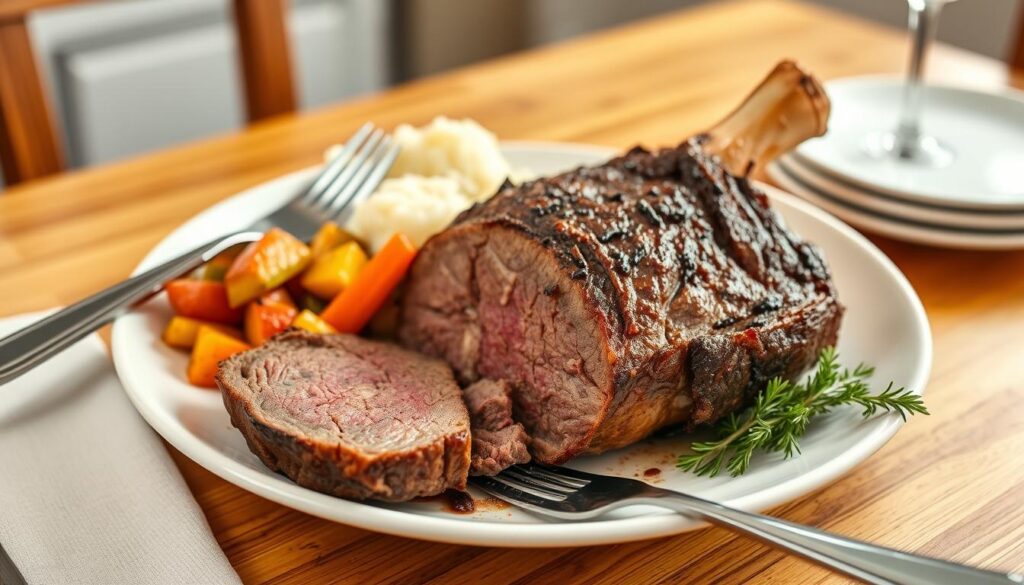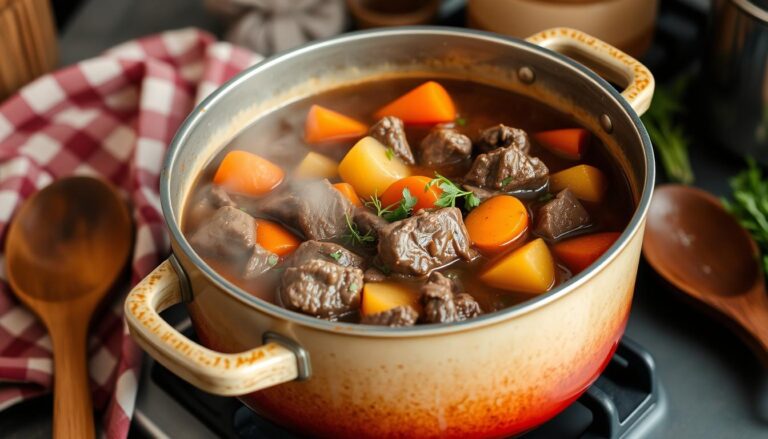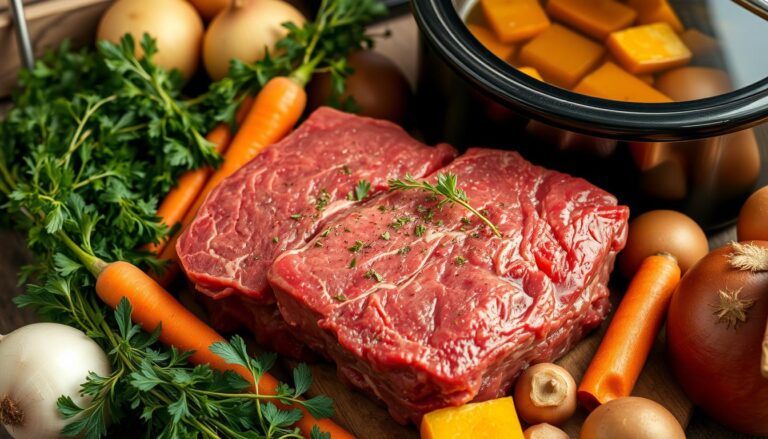The Ultimate Guide to Beef Chuck Roast Nutrition Facts
Every kitchen has its own story, and mine often starts with a beef chuck roast. Growing up, my family loved cooking meals together. We learned that knowing about beef chuck roast nutrition is more than just numbers. It’s about feeding your body and soul.
If you’re into fitness or just love cooking, this guide is for you. We’ll explore the nutritional side of beef chuck roast. You’ll see how this cut can be both tasty and nutritious.
Beef chuck roast is full of protein, making your meals special. It’s great for muscles and packed with important minerals. This cut is a must-have in your diet.
Table of Contents
Understanding Beef Chuck Roast Basics
Exploring chuck roast is a tasty adventure into a flavorful beef cut. It’s not just about the macros; it’s a culinary journey.
The chuck roast comes from the cow’s upper front shoulder. It’s known for its marbling and strong flavor. Culinary experts love this cut for its versatility and delicious dishes.
Defining the Chuck Roast Cut
To understand chuck roast, start with its unique traits:
- It comes from the cow’s shoulder.
- It has a lot of marbling for better flavor.
- It usually weighs 4-5 pounds.
Common Names and Variations
In different places, you might find it called other names. Some common ones are:
- Shoulder roast
- Pot roast
- Boston cut
“The chuck roast is a testament to the art of slow cooking, transforming a tough cut into a tender, flavorful masterpiece.” – Culinary Experts
Ideal Cooking Methods Overview
When looking at chuck roast’s protein, knowing how to cook it is key. Slow cooking, like braising and pot roasting, is best. It makes the meat tender and flavorful.
Here are some top cooking methods:
- Braising: Slow cooking in liquid
- Pot roasting: Oven-based method with veggies
- Slow cooker: Easy all-day cooking
Pro tip: Cook it to 145°F (63°C) for a safe and tasty chuck roast.
Beef Chuck Roast Nutrition Profile
Knowing the nutritional value of chuck roast is key to making smart food choices. A typical serving of chuck roast is packed with nutrients that support your health. When you make a beef stroganoff recipe, you’ll understand the nutrients you’re getting.
The protein in chuck roast is a big plus. A 3.5-ounce serving has about 26 grams of protein. This is great for building and repairing muscles.
Here’s a look at the main nutrients:
- Protein: Essential for muscle development
- Chuck roast calories cooked: Approximately 217 per serving
- Fat content: Moderate, with about 11.8 grams per serving
“Nutrition is not just about calories, but about the quality of nutrients you consume.” – Nutrition Expert
The sodium in chuck roast is moderate, with 70-90 milligrams per serving. This is good news for those watching their salt intake.
| Nutrient | Amount per 3.5 oz Serving |
|---|---|
| Protein | 26.1g |
| Total Calories | 217 |
| Fat | 11.8g |
| Sodium | 75mg |
Pro tip: Choose lean cuts and trim visible fat to optimize the nutritional profile of your chuck roast.
Caloric Content and Macronutrient Breakdown
Knowing the nutritional facts of chuck roast helps you make better food choices. It’s a great source of protein, which is key for muscle health and overall well-being.
Protein Content per Serving
Chuck roast is a top-notch protein source. A 3-ounce serving has about 26 grams of protein. This makes it perfect for building and keeping muscle.
Fat Distribution Analysis
Beef chuck roast has a moderate amount of fat. The fat mix includes:
- Saturated fats: About 3-7 grams per serving
- Monounsaturated fats: Good for heart health
- Polyunsaturated fats: Adds to nutritional balance
Carbohydrate Considerations
Chuck roast is low in carbs, with almost none. This makes it great for diets that limit carbs, like low-carb and ketogenic diets.
| Nutrient | Amount per 3 oz Serving |
|---|---|
| Calories | 179 |
| Total Fat | 7.6g |
| Protein | 26g |
| Carbohydrates | 0g |
“Meat is one of the most complete dietary sources of protein, with an amino acid profile nearly identical to human muscle tissue.”
When picking chuck roast, go for Select grade cuts. They have 5% to 20% less fat than Choice beef, which is better for health.
Essential Vitamins and Minerals
Beef chuck roast is a nutritional powerhouse. It’s packed with vitamins and minerals that boost your health. While many focus on its fat content, its micronutrients are just as impressive.
Let’s look at the key vitamins and minerals in beef chuck roast:
- Zinc: Crucial for immune function and body growth
- Selenium: Supports thyroid health and acts as an antioxidant
- Iron: Promotes oxygen transportation in the blood
- B Vitamins: Essential for energy production and metabolism
The vitamins in beef chuck roast are noteworthy. Vitamin B12, for example, is vital for red blood cells and brain function. A 3-ounce serving gives you over 50% of your daily B12 needs.
“Beef is more than just protein—it’s a complete nutritional package.” – Nutrition Expert
Beef chuck roast minerals like zinc and iron are also key. Zinc boosts your immune system. The heme iron in beef is better absorbed by your body than plant-based iron.
| Nutrient | Amount per 100g | Key Benefits |
|---|---|---|
| Zinc | 4.8 mg | Immune function support |
| Vitamin B12 | 2.4 mcg | Nerve function and cognitive health |
| Iron | 2.6 mg | Oxygen transportation |
Adding beef chuck roast to your diet is more than just a tasty meal. It’s a way to give your body a wealth of essential nutrients. These nutrients support your overall health and wellness.
Health Benefits of Chuck Roast
Beef chuck roast is more than just a tasty meal. It’s packed with nutrients that boost your health. It helps with muscle growth and supports your immune system.
Muscle Growth and Maintenance
Your body needs good protein to build and fix muscles. Beef chuck roast is rich in protein, great for muscle growth. It’s perfect for athletes and anyone who’s active, helping muscles recover after hard workouts.
Iron Absorption Benefits
The iron in beef chuck roast is a key nutrient. It’s heme iron, which your body absorbs better than iron from plants. This helps keep your iron levels up and fights off anemia. Iron is vital for carrying oxygen and energy in your body.
- Heme iron promotes better absorption
- Supports oxygen transportation
- Enhances energy metabolism
Zinc and Immune Support
Zinc in beef chuck roast is key for a strong immune system. It helps your immune cells work right, aids in healing wounds, and supports DNA. Eating chuck roast regularly can boost your body’s defenses.
“Beef is not just food, it’s nutrition with purpose.” – Nutritional Expert
Knowing these health benefits helps you make better food choices. Eat chuck roast as part of a balanced diet for the best nutrition.
Comparing Chuck Roast to Other Beef Cuts
Knowing how beef chuck roast compares to other cuts helps you make better food choices. Looking at beef chuck roast macros shows big differences. These differences affect your diet.

Let’s compare beef chuck roast serving size and nutrition with other cuts. The beef stew preparation often depends on the cut’s characteristics.
| Beef Cut | Calories/100g | Fat (g) | Protein (g) |
|---|---|---|---|
| Chuck Blade Roast | 334 | 24.1 | 27.2 |
| Chuck Arm Pot Roast | 295 | 18.5 | 30.0 |
| Bottom Sirloin | 221 | 12.4 | 25.7 |
| Flank Steak | 192 | 8.23 | 27.7 |
Exploring beef chuck roast cooking methods shows different cuts need unique approaches. Chuck roast typically has higher fat content. This makes it rich in flavor and tender.
- Chuck Blade Roast offers the highest calories per 100g
- Flank steak provides the leanest option
- Chuck Arm Pot Roast balances protein and fat content
“Not all beef cuts are created equal – understanding their differences can elevate your culinary and nutritional experience.”
Your choice depends on your nutritional goals, cooking style, and taste preferences. Whether you want high protein, low fat, or great taste, there’s a perfect cut for you.
Cooking Methods Impact on Nutrition
Cooking your beef chuck roast is more than just making a tasty meal. It’s about keeping its nutrients intact. Different cooking methods can change how much protein and minerals stay in the meat.
When you cook beef chuck roast, knowing how cooking methods affect nutrition is key. The right method can boost the meat’s muscle-building potential and keep more nutrients.
Slow Cooking Benefits
Slow cooking is a top choice for beef chuck roast. This gentle method breaks down tough meat, making it tender and possibly more nutritious.
- Preserves up to 90% of original nutrients
- Helps maintain protein integrity
- Reduces moisture loss compared to high-heat methods
Braising Nutritional Effects
Braising is another great way to cook beef chuck roast. It cooks the meat in liquid at low temperatures, keeping more nutrients and making flavors richer.
| Cooking Method | Nutrient Retention | Protein Preservation |
|---|---|---|
| Slow Cooking | 90% | High |
| Braising | 85% | Very Good |
| Grilling | 70% | Moderate |
Temperature Considerations
For beef chuck roast, keeping the temperature right is key. Cooking between 140-153°F is best for protein and keeping the meat moist and nutritious.
*Precision in cooking temperature can make the difference between a nutritious meal and a nutrient-depleted dish.*
Learning about these cooking techniques helps you make meals that are both tasty and full of nutrients.
Portion Control and Serving Recommendations

Knowing how much to eat is key when adding beef chuck roast to your diet. A good serving size is about 3 ounces (85 grams). This is roughly the size of a deck of cards. It helps keep your intake of cholesterol and saturated fat in check while still getting important nutrients.
For those looking to lose weight, controlling portions is even more important. Your serving size can greatly affect your nutritional goals:
- Aim for 3-ounce portions to control calorie intake
- Pair with vegetables to create balanced meals
- Use lean cooking methods to reduce additional fat
Nutrition experts suggest keeping track of how much beef chuck roast you eat. A typical 3-ounce serving has about 179 calories, 26 grams of protein, and 7.6 grams of fat. Being aware of these numbers helps you manage your diet better.
“Moderation is key when enjoying beef chuck roast as part of a balanced diet.” – Nutrition Experts
To help with weight management and heart health, try these portion control tips:
- Use a food scale to measure precise portions
- Fill half your plate with vegetables
- Choose leaner cuts with less marbling
Keep in mind, everyone’s nutritional needs are different. Talking to a registered dietitian can help you tailor your diet to include beef chuck roast. This way, you can meet your health goals.
Selecting and Storing Chuck Roast
Choosing the perfect chuck roast is all about detail. Look for cuts with lots of marbling to see the beef chuck roast collagen content. A good roast weighs 2.5 to 5 pounds, making it easy to cook.
When picking a roast, consider these important factors:
- Color: Choose a rich, deep red meat with even color
- Marbling: Find cuts with fat evenly spread out
- Freshness: Check the sell-by date and make sure the package is good
The nutritional value of your chuck roast depends on the cow’s diet. Grass-fed beef has more good beef chuck roast amino acids than grain-fed beef.
“A great roast begins with careful selection and proper storage.” – Culinary Experts
Storing your roast right is key to keeping its nutrients. Keep it in the fridge at 40°F or below. Use it within 3-5 days. For longer storage, freeze it right away. It stays safe for 4-12 months in the freezer.
| Storage Method | Duration |
|---|---|
| Refrigerator | 3-5 days |
| Freezer | 4-12 months |
Pro tip: Wrap your chuck roast tightly in butcher paper or vacuum-sealed packaging. This prevents freezer burn and keeps its nutrients.
Tips for Healthier Chuck Roast Preparation
Preparing chuck roast can be both delicious and nutritious. Smart cooking techniques make a big difference. Your approach to preparing this flavorful cut can significantly impact its nutritional value and health benefits.

Mastering the art of chuck roast preparation is key. It’s about maximizing nutritional potential while cutting down on calories.
Fat Trimming Strategies
Reducing chuck roast fat content doesn’t mean losing flavor. Try these expert techniques:
- Use a sharp knife to carefully remove visible fat layers
- Choose leaner cuts with minimal marbling
- Drain excess fat after initial cooking
Smart Seasoning Approaches
Enhance your chuck roast protein profile with clever seasoning techniques. These boost flavor without excess sodium:
- Use fresh herbs like rosemary and thyme
- Experiment with spice blends
- Avoid pre-mixed seasoning packets high in salt
Vegetable Pairing Recommendations
| Vegetable | Nutritional Benefit |
|---|---|
| Carrots | High in vitamin A, supports eye health |
| Brussels Sprouts | Rich in fiber, supports digestion |
| Sweet Potatoes | Provides complex carbohydrates |
Learn more about delicious meat preparation techniques at Hearty Meat Recipes. By implementing these strategies, you’ll transform your chuck roast into a nutritious, satisfying meal that supports your health goals.
Pro Tip: Always let your meat rest after cooking to retain maximum juiciness and nutritional integrity.
Conclusion
Learning about lean chuck roast cuts can change how you eat. It’s packed with protein and important minerals. This meat is not just tasty, but also very nutritious.
The culinary potential of chuck roast goes beyond just cooking. It’s a key part of a healthy diet.
Exploring how to cook chuck roast shows the need for careful preparation. Ground chuck, with 80% lean meat, is great for muscle health. Choosing the right cuts and cooking methods is key to keeping it nutritious.
Nutrition experts say to add chuck roast to your diet wisely. By picking lean cuts and controlling portions, you can get its protein and minerals without harming your health. The way you cook it also matters a lot.
As you continue, use what you’ve learned to make better food choices. Chuck roast is more than a protein source. It’s a nutritional gem that can boost your health if eaten thoughtfully.







